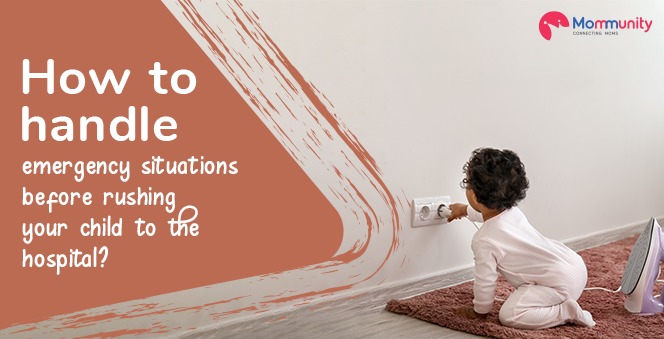Looking after a newborn could be incredibly overwhelming. You need to understand when they feel sleepy or hungry, just by their way of crying. Although crying is normal, sometimes they do it non-stop without any reason, indicating some serious issues. Usually, this happens when the baby is feeling bloaty or is colic (an unexplained digestive difficulty). Should you give gripe water to your baby?
If you’re the parent of a fussy baby, chances are, you’ve received several suggestions from other people on how to soothe and comfort your baby. If your baby has colic, friends and family members may suggest walking the baby around, going for a long drive at night, eliminating certain foods from your diet, and giving your baby gripe water.
Many parents trust its abilities. But offering your baby a supplement is not something that you should do without deliberate consideration. Mommunity gives you a closer look at its pros and cons, its effectiveness, and majorly its safety.
WHAT IS GRIPE WATER?
Gripe water is a liquid solution intended to relieve the discomfort caused by flatulence, colic, indigestion, hiccups, and teething pain. There are different kinds of this liquid available, and they comprise a mixture of different herbs(like fennel, ginger, chamomile, dill, lemon balm or peppermint, according to the formula).
IS IT SAFE?
It is not scientifically proven that gripe water is safe or unsafe for the baby. Its impact is subjective. Some mothers have found gripe water helpful, whereas others found it of no significant benefit to the baby but not necessarily unsafe. Below are some details about the prominent ingredients in gripe water, to assist you decide whether or not to give the supplement to your baby:
1. Alcohol is certainly bad for the baby: It was originally believed that it was the alcohol content in the gripe water that had a soothing effect on the baby. According to research, alcohol is not a necessary ingredient and, in fact, may make the baby addicted to gripe water. There have been cases of adults getting addicted to gripe water that contained alcohol.
2. Sodium bicarbonate can alleviate acidity: Sodium bicarbonate or baking soda is an ingredient that has been consistently used in gripe water since its formulation. It is called sarjikakshara in India. Sodium bicarbonate deals with the acid reflux the baby may have due to an underdeveloped esophageal valve present at the point esophagus meets the stomach. Since babies younger than six months consume only breast milk, they can be at a greater risk of developing the problem of Milk-alkali Syndrome, in case they are repeatedly administered gripe water. It can affect the kidneys of the baby in the long run.
3. Certain herbs can help digestion: Fennel, or saunf as called in India, is a common mouth freshener served after meals primarily for its ability to mitigate indigestion. Fennel seed oil significantly relieves colic behavior especially if the baby is crying due to gastrointestinal discomfort. Although fennel and dill are popular natural remedies for indigestion, however, there are no elaborate studies to conclude their therapeutic uses for babies.
4. It is the sugar that actually soothes: Studies have shown that it is the sweet taste of sugar has a calming effect on colic babies. But excess sugar can lead to decay in the developing teeth of the baby since it is harmful to the gums and teeth. Check the quantity of added sugar mentioned on the label before buying. Also, maintain a watch on how much gripe water you are giving your baby to prevent feeding them excess sugar.
5. Gripe water ingredients are capable of providing relief independently: The isolated ingredients of gripe water are independently capable of providing relief to colic babies. This means It isn’t required to take the risk of giving a mix of ingredients to your baby when you can provide them one at a time.
6. No scientific evidence about the effectiveness: Scientific research has not yielded conclusive evidence that gripe water treats colic babies. However, they do consider it as an alternative medicine for colic. It is not a formal medicinal treatment for a windy baby and can be recommended as an over-the-counter remedy for temporary relief.
7. It does not cause diarrhea or constipation: Gripe water does not lead to diarrhea as generally perceived by many parents, they share cases where their baby developed a slumped toilet schedule after the consumption of gripe water, but there is no evidence that directly links gripe water with constipation or diarrhea.
POSSIBLE SIDE-EFFECTS
There are no scientifically-proven side effects of gripe water. However, your baby could be allergic to one or more of the ingredients in a particular brand. Checking the list of ingredients will probably help you avoid those brands. Hives, watery eyes, swollen lips or tongue, vomiting, itchiness, and any change in your baby’s breathing pattern after consuming gripe water are a few signs of an allergic reaction.
USES OF GRIPE WATER
Gripe water has been believed to be beneficial for colic babies and those suffering from gastrointestinal problems. Below are some of the common uses of gripe water:
1. Colic babies: Gripe water has been historically advertised for colic. It is popularly used to soothe babies having a tendency to break into chronic colic.
2. Fretful babies: Babies that cry due to shock or pain can be comforted with a dose of gripe water. It works similarly as it does for colic babies.
3. Baby having tummy problems: Gripe water is often recommended for babies suffering from gastrointestinal troubles, including acidity. It is recommended for constipation as well, though it is not meant for it.
4. Gripe water for teething: Teething can cause irritation in babies, which in turn may make them cry quite frequently. This frequent crying results in swallowing a lot of air since there are no teeth to block. This may indirectly lead to flatulence.
5. Gripe water for hiccups: Hiccups are caused by irritation of the diaphragm in the abdominal cavity. The irritation can be prompted by flatulence, acid reflux or general indigestion. However, gripe water does not directly treat baby hiccups, instead targets the probable causes of diaphragm irritation.
WHEN TO GIVE IT TO THE BABY?
The manufacturers of gripe water assert that it can be given to babies as young as two weeks. However, it is not advisable to give it to babies under the age of six months, since their digestive system is still developing and is sensitive. Many people also believe that babies should not be fed anything apart from breast milk or formula until they are six months old. So, the optimal option is to consult with your pediatrician before giving gripe water to your baby.
HOW TO GIVE IT TO THE BABY?
1. Read the ingredients carefully. Look out for vegetable carbon (a kind of charcoal that is sometimes labeled as carbo vegetables), which may cause constipation.
2. Read the instructions. The ingredients may differ from brand to brand, and most brands have different instructions. So read the label carefully before tearing open the box (and again, ask your pediatrician about brands, dosing, and use before giving it to your little one). Some brands recommend waiting until your baby is at least 1 month old before use.
ALTERNATIVES TO GRIPE WATER
If you’re not completely comfortable using gripe water to soothe your child’s symptoms and calm those cries, here are some alternatives to gripe water:
1. Try anti-gas drops. Antigas drops may be better for your baby than gripe water. Ask your pediatrician before trying these drops, whose active ingredient is simethicone (which breaks up gas bubbles).
2. Do a formula check. If your gas-prone baby has just started on formula, try a ready-to-feed or concentrated variety rather than a powder mix. All the shaking and stirring creates bubbles that could unsettle a baby’s delicate tummy. If she loves her powder formula and you don’t want to change it, take more than a minute or two after mixing to make sure the formula has settled before feeding.
3. Slow the flow. Try tipping the bottle so formula or breast milk completely fills the nipple and replaces unwanted air bubbles. If that doesn’t seem to work, ask your pediatrician about swapping your baby’s bottle for one designed to hold back the trapped bubbles. Burping after they’re fed can help minimize air bubbles too.
4. Give an infant massage. A nice, relaxing rubdown is often a soothing way to calm a fussy infant and ease gas pain.
5. Swaddle away. Wrap up your baby comfortably in a warm blanket. Try rocking and dancing while holding her in your arms for some extended soothing sensation.
6. Apply tummy pressure. Some babies find relief when pressure is applied to their bellies. Simply let your baby sit up on your lap with their tummy against your hand, then gently rub or pat their back. Or lie them on their back and rub their tummy gently with one hand.
7. Bicycle her legs. Sometimes moving your baby’s legs around and around in a bicycle-wheel motion helps relieve the gas which may be causing her so much discomfort.
8. Soothe with sounds. Try singing a little song your baby will probably love it. Calmly humming or whispering “shh” in baby’s ear can also do the trick, because they may remind them of the womb.
9. Do a diet check, if everything else fails. If you’re a lactating mother, monitor what you may be eating or drinking. Try omitting common gas culprits like dairy or soy from your diet, that might cause digestive problems and discomfort in your newborn, one at a time to see if there’s any improvement.
While we do not endorse for the safety of, what we recommend is that read the ingredients, and make an informed choice after consulting your pediatrician.
What was your experience? Share it with us here.




